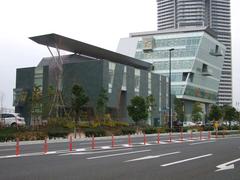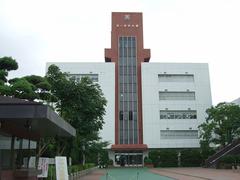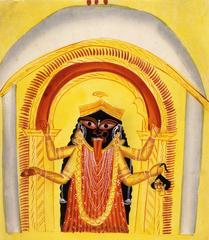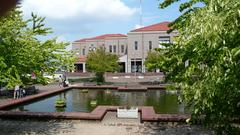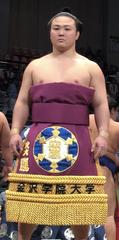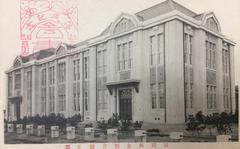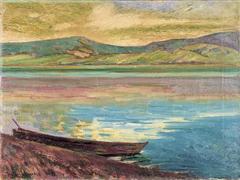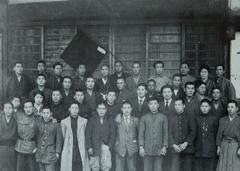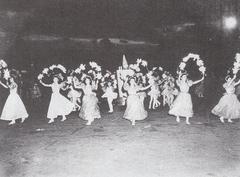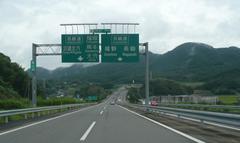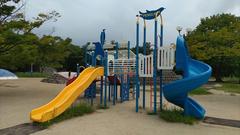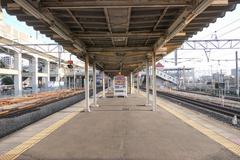Kashii-Gū Visiting Hours, Tickets, and Fukuoka Historical Sites Guide
Date: 14/06/2025
Introduction to Kashii-Gū: History and Cultural Significance
Kashii-Gū Shrine (香椎宮), located in Higashi-ku, Fukuoka, stands as a remarkable monument to Japan’s imperial heritage and Shinto traditions. Founded around 200 AD, Kashii-Gū is deeply rooted in the legends of Emperor Chūai, Empress Jingū, and Emperor Ōjin, making it one of the nation’s oldest and most revered Shinto shrines. Its recognition as a chokusaisha—one of only seventeen shrines honored with imperial envoy ceremonies—emphasizes its enduring significance within Japanese history and culture (Japan Today; Fukuoka Now).
The shrine showcases the distinctive Kashii-zukuri architectural style, unique to Kashii-Gū, with its elegant curved roofs, brilliant vermillion and lacquer finishes, and ancient wooden construction. The serene grounds are adorned with sacred camphor and cedar trees, tranquil ponds, and auxiliary shrines—each contributing to an atmosphere that blends the spiritual and natural worlds (Shinto Miraheze; Crossroad Fukuoka).
Kashii-Gū serves as a vibrant center for community life, hosting traditional events such as the Setsubun bean-throwing ceremony, the Iris Festival, and other seasonal celebrations that attract both locals and visitors. The shrine is especially revered by expectant mothers seeking blessings, reflecting its deep association with Empress Jingū’s legendary pregnancy (Fukuoka Now).
Accessible by public transportation and open daily with free admission, Kashii-Gū is an essential destination for anyone interested in Fukuoka historical sites, Japanese spirituality, and cultural heritage (Fukuoka Heritage Week; Kashii-Gū Official Website).
Table of Contents
- Introduction
- Legendary Origins and Early History
- Imperial Rites and Court Patronage
- Enshrined Deities and Symbolic Roles
- Architectural Heritage and Cultural Designation
- Shrine Grounds and Layout
- Sacred Trees and Natural Features
- Auxiliary Shrines and Unique Guardians
- The Spring of Immortality (Furosui)
- Seasonal Beauty and Festival Spaces
- Festivals and Special Events
- Visiting Kashii-Gū: Hours, Tickets & Access
- Visitor Experience During Festivals
- Nearby Attractions and Travel Tips
- Accessibility and Inclusivity
- Frequently Asked Questions (FAQ)
- Visuals and Media
- Related Articles
- Conclusion and Travel Tips
Legendary Origins and Early History
According to tradition, Kashii-Gū’s foundation dates back to 200 AD and is closely linked to Emperor Chūai and Empress Jingū. After Emperor Chūai’s death at this site—following his refusal to heed a divine vision—Empress Jingū, while pregnant, led a legendary campaign and established the shrine to honor his spirit and the gods who guided them. Their son, Emperor Ōjin, is also enshrined here, further cementing the shrine’s imperial legacy (Japan Today; Fukuoka Now).
Imperial Rites and Court Patronage
Kashii-Gū is distinguished as one of Japan’s seventeen chokusaisha, shrines that have received imperial envoys since the 8th century. These envoys deliver offerings and court decrees during special rites, a tradition that highlights the shrine’s enduring spiritual and political significance. The approach to the shrine, known as Imperial Envoy Road, features 165 camphor trees, symbolizing the unity of Fukuoka’s municipalities (Japan Today).
Enshrined Deities and Symbolic Roles
The principal deities enshrined at Kashii-Gū are Emperor Chūai, Empress Jingū, and Emperor Ōjin, along with the Sumiyoshi Sanjin—sea gods believed to have protected Empress Jingū’s expedition. The shrine is particularly visited by expectant mothers, couples seeking blessings for love and harmony, and those wishing for safe childbirth.
Architectural Heritage and Cultural Designation
Rebuilt in 1801 under Lord Nagayori Kuroda, the main hall of Kashii-Gū is the sole example of the Kashii-zukuri architectural style. This style is characterized by sweeping curved roofs, vivid vermillion and black lacquer, and intricate woodwork. The main hall, haiden (worship hall), and heiden (offering hall) are aligned in a straight axis, all connected by corridors (Fukuoka Now; Shinto Miraheze). The shrine’s architecture is officially designated as an Important Cultural Property.
Shrine Grounds and Layout
Kashii-Gū’s expansive grounds feature an 800-meter sandō (approach) lined with camphor trees, a stately rōmon (two-storied gate), traditional stone lanterns, and tranquil ponds. The gardens are particularly beautiful in June, when irises bloom in abundance (Blog Dekitabi; Gofukuoka).
Key features:
- Rōmon Gate: The grand entrance to the shrine.
- Stone Lanterns and Torii: Mark sacred spaces throughout the grounds.
- Moss-Covered Steps: Picturesque in both spring and autumn.
- Ponds and Gardens: Home to irises, koi, and turtles.
Sacred Trees and Natural Features
- Sacred Cedar (Ayasugi): Believed to be over 1,800 years old and planted by Empress Jingū.
- Camphor Trees: The sandō is flanked by 165 camphor trees, each symbolizing a Fukuoka municipality.
- Pine Tree: Another ancient tree attributed to Empress Jingū’s planting (Shinto Miraheze; Gofukuoka).
Auxiliary Shrines and Unique Guardians
- Takeuchi Shrine: Dedicated to Takenouchi no Sukune, a legendary statesman known for his longevity (JPShrine).
- Keiseki Shrine: Features rare komadori (guardian chickens) instead of the usual komainu, one of only two such pairs in Japan (Tsunagu Japan).
- Komainu: The main shrine’s guardian statues are noted for their distinctive physique and small heads.
The Spring of Immortality (Furosui)
The Furosui, or “Water of Eternal Youth,” is a nearby natural spring celebrated for its pure water and legendary powers. Recognized among Japan’s top 100 famous waters, the spring was famously used by Takenouchi no Sukune to maintain his longevity (Japan Today; JPShrine). Visitors may sample the water until 3:00 PM daily.
Seasonal Beauty and Festival Spaces
The shrine’s landscape changes with the seasons:
- Spring: Lush greenery and vibrant irises.
- Autumn: Brilliant foliage along the mossy steps and camphor-lined approach.
- Festivals: Spaces are used for major events such as the Shinko Matsuri and yabusame (horseback archery) displays (Crossroad Fukuoka; Gofukuoka).
Festivals and Special Events
Setsubun Festival
Held in early February, Setsubun marks the transition from winter to spring with the lively mamemaki (bean-throwing) ritual. Ceremonies are held at 13:00 and 16:00, and visitors can participate in the bean collection and walk through the Otafuku mask gate for luck (Fukuoka Now).
Iris Festival
Taking place in June, this festival celebrates the blooming of over 5,000 irises around the shrine’s pond, accompanied by cultural performances.
Grand Spring and Autumn Festivals
The shrine hosts major rites, including processions, traditional music and dance, and yabusame displays.
Visiting Kashii-Gū: Hours, Tickets & Access
- Hours: Open daily from 6:00 AM to 6:00 PM; hours may be extended during festivals (Kashii-Gū Official Website).
- Admission: Free entry to shrine grounds; some events or exhibitions may require tickets.
- Access: A short walk from JR Kashii-Jingu Station; also accessible from Nishitetsu Kashiigu-mae and JR Kashii stations. Parking is available but limited (Fukuoka Now).
- Best Time to Visit: June for the Iris Festival or early mornings for tranquility.
Visitor Experience During Festivals
Festivals at Kashii-Gū offer a vivid look into traditional Japanese rituals. During Setsubun, the grounds are filled with families, the sound of bean-throwing, and the lively Otafuku gate. The Iris Festival immerses visitors in seasonal beauty. Participation is encouraged, and most activities are free.
Accessibility and Inclusivity
- Barrier-free access with ramps and accessible restrooms.
- Multilingual signage and brochures.
- Staff are available to assist visitors with special needs.
Nearby Attractions and Travel Tips
- Nanzoin Temple: Home to one of the world’s largest reclining Buddha statues (Blog Dekitabi).
- Dazaifu Tenmangū Shrine: Another key historical site.
- Fukuoka Asian Art Museum, Hakata Old Town: For broader cultural exploration.
Travel tip: Comfortable shoes are recommended; visit early to enjoy the quiet and avoid crowds during festival times.
Frequently Asked Questions (FAQ)
Q: What are Kashii-Gū’s opening hours?
A: 6:00 AM to 6:00 PM; check the official website for changes during festivals.
Q: Is there an entrance fee?
A: Entry is free; certain special exhibits or amulets may require a fee.
Q: Are guided tours available?
A: Not regularly onsite, but inquire at the office or use audio guides or apps.
Q: Is the shrine wheelchair accessible?
A: Main paths and restrooms are accessible; some areas with steps may require assistance.
Q: Can visitors drink from the Spring of Immortality?
A: Yes, from 6:00 AM to 3:00 PM daily.
Visuals and Media
- Photo of Kashii-Gū Shrine’s main gate (alt text: “Kashii-Gū Shrine main gate showcasing traditional Kashii-zukuri architecture”)
- Image of the sacred camphor tree (alt text: “Ancient sacred camphor tree at Kashii-Gū, symbolizing spiritual heritage”)
- Map of Kashii-Gū’s location and nearby sites (alt text: “Map showing Kashii-Gū Shrine and nearby Fukuoka historical sites”)
- Video of the Iris Festival (alt text: “Traditional dance and music at Kashii-Gū’s Iris Festival”)
Related Articles
- Exploring Fukuoka’s Historical Sites: A Cultural Journey
- Traditional Festivals in Fukuoka: Celebrations at Kashii-Gū and Beyond
- Sacred Forests of Japan: The Spiritual Significance of Chinju no Mori
Conclusion and Visitor Recommendations
Kashii-Gū Shrine is a unique destination where Japan’s imperial mythology, spiritual tradition, and natural beauty converge. Its historical significance as a chokusaisha, distinctive architecture, and seasonal festivals make it a highlight for anyone exploring Fukuoka. With barrier-free access, multilingual resources, and a welcoming atmosphere, Kashii-Gū ensures a fulfilling visit for all.
For current hours, festival dates, and travel updates, always consult the Kashii-Gū official website and Fukuoka Heritage Week. Enhance your experience with guided tours via the Audiala app, and be sure to explore nearby landmarks for a deeper dive into Fukuoka’s rich history.
Plan your journey now to experience the timeless allure and living traditions of Kashii-Gū Shrine in Fukuoka!
References and Further Reading
- Japan Today
- Fukuoka Now
- Shinto Miraheze
- Fukuoka Now (Setsubun Guide)
- Fukuoka Heritage Week
- Kashii-Gū Official Website
- Crossroad Fukuoka
- Gofukuoka
- Tsunagu Japan
- Audiala App
- JPShrine
- Blog Dekitabi
- Fukuoka Tourism Official Website

